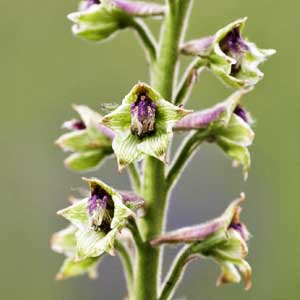Delphinium viridescens
Delphinium sect. Diedropetala
Wenatchee larkspur
2-80 cm, tuberlike or fibrous, dry or fleshy;
buds often less than 3 mm.
90-150 cm;
base usually green, glabrous.
1-8(-19) per root;
base firmly attached to root or not.
blade cuneate to semicircular, 2-5 × 3-12 cm, nearly glabrous; ultimate lobes 3-21, width 1-8 mm.
cauline and/or in basal rosette, gradually or abruptly reduced into bracts.
25-80-flowered, dense;
pedicel 0.5-2 cm, glandular-pubescent;
bracteoles 1-4 mm from flowers, green, lanceolate, 3.5-6 mm, glandular-pubescent.
sepals yellowish green, nearly glabrous, lateral sepals forward pointing, 7-9 × 3-4 mm, spurs decurved, 30-45° below horizontal, often hooked apically, 8-11 mm;
lower petal blades ± covering stamens, 4-6 mm, clefts 0.5-1.5 mm;
hairs centered, mostly near junction of blade and claw, yellow.
sepals blue, purple, white, red, or yellow;
lower petal blades often same color as lateral sepals, usually greater than 1/5 length of lateral sepals (exceptions in red- and yellow-flowered species).
8-11 mm, 2.5-3 times longer than wide, puberulent.
± wing-margined;
seed coat cells with surfaces ± roughened.
Delphinium viridescens
Delphinium sect. Diedropetala
Of conservation concern.
Delphinium viridescens is local in mountains southwest of Wenatchee, Washington.
(Discussion copyrighted by Flora of North America; reprinted with permission.)


